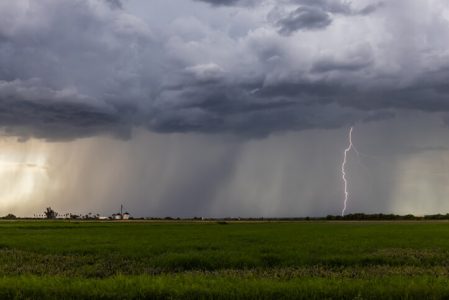Navigating Through Microbursts
Microbursts are sudden downdrafts caused by winds that rapidly change direction and speed, usually over a short distance. They can occur in any weather condition and often go unnoticed until they hit the ground and cause wind shear. Fortunately, due to their nature as localized events, it is possible to spot them ahead of time if you know what to look for. Let’s take a look at some tell-tale signs of an impending microburst and what you can do to help mitigate their effects.
Tell-Tale Sign of a Microburst
The most significant sign of a microburst is an approaching storm cell with unstable atmospheric conditions. As the aircraft approaches such a storm, the pilot should look for signs of turbulence or downdrafts which could indicate a potential microburst hazard. If such signs are present, the pilot should seek to deviate from the planned route by climbing or turning away from the storm cell before entering it.
You may also notice other aircraft navigating around large gust fronts or other turbulence associated with the storm. If you see these signs, be extra vigilant and plan your course around the area to avoid the microburst.
Know Your Aircraft
In addition to avoiding areas of potential microbursts, pilots must also be aware of their aircraft’s limitations when flying in windy conditions. Rapidly changing winds can cause sudden changes in airspeed and altitude, resulting in loss of control if not managed correctly. Therefore, it is important for pilots to monitor weather conditions carefully and adjust their speed accordingly. This includes checking for strong gusts on landing approach which can lead to an unstable touchdown.
When Avoidance Doesn’t Happen
If you happen to encounter a microburst while flying, there are steps that you can take to navigate safely and limit the impact of turbulence.
- The first step is to reduce speed as much as possible without compromising control of the aircraft; this will allow more time for reaction.
- If you find yourself in an updraft, start climbing slowly and adjust course slightly outward from the center of the storm cell.
- If it’s a downdraft, descend slowly and adjust course slightly toward the center.
- You should also be aware of any wind shear associated with the microburst and make corrections accordingly.
- Finally, it’s essential to keep a close watch on the instruments and be prepared for last-minute course adjustments if needed.
By following these steps and remaining vigilant, you should be able to safely navigate through a microburst. Remember: knowledge is power – the more you know about microbursts, the less of a threat they’ll become.
Vigilance
Additionally, pilots must always remain vigilant and observant while navigating through potentially hazardous microburst conditions. This includes being alert for changes in attitude, altitude or speed and having a solid plan of action to adjust accordingly. By understanding the potential risks associated with microbursts and following these safety guidelines, pilots can ensure they are prepared for any turbulent conditions they encounter while flying.
By being aware of the dangers posed by microbursts and taking appropriate precautions when flying near storms, pilots can maximize their safety and avoid potentially disastrous scenarios. By following these guidelines and always remaining vigilant, pilots can safely navigate through even the most challenging weather conditions.
RELATED READING
RELATED CTS TRAINING










